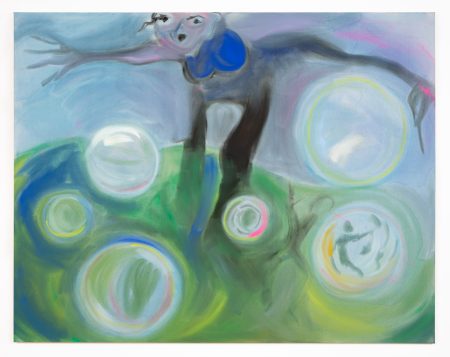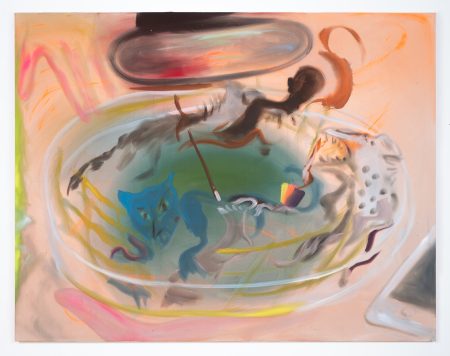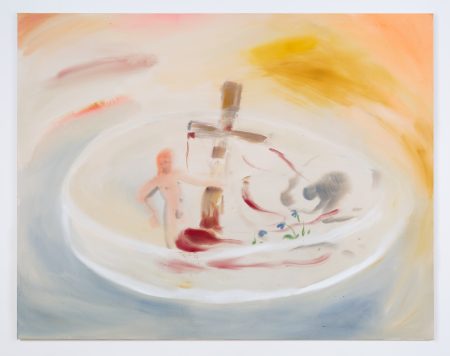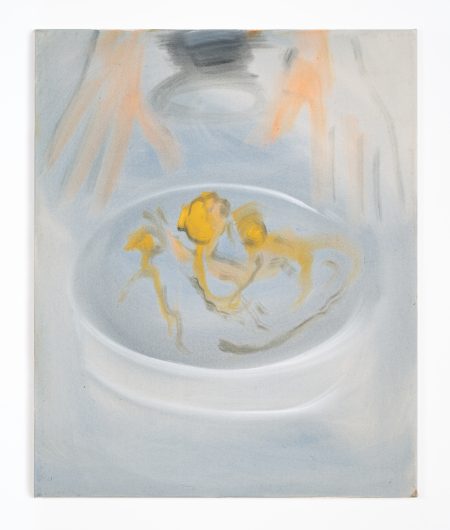Cleverly convoluting scientific and sociological meanings of the word “culture,” Sophie von Hellermann’s paintings portray clear disks brimming with mysterious vignettes in “Petri Dishes,” her show at Parrasch Heijnen Gallery in Los Angeles. Each canvas functions as a petri dish for von Hellermann’s painted explorations where microbiologic vessels serve as symbolic spheres for testing paint’s properties and experimenting with human microcosms.
With boundless variations potentially occurring within its limited framework, the petri dish is an ingenious metaphor for the chance and creativity inherent to painting. Artists and scientists both quest insight. Just as scientists mix ingredients on agar plates, painters spread fluid material over flat surfaces, having some goal in mind but never knowing exactly what will happen.

Von Hellermann emphasizes this unpredictability via loose brushwork that leaves her subjects’ identities and her scenarios’ purport open to interpretation. Incipient figures and creatures emerge as from organic material within dreamily indefinite scenes seeming to swirl around in fluctuant vortexes.
Von Hellermann paints with watery acrylic on unprimed canvas—a one-shot technique that can’t easily be corrected, for each brushstroke soaks indelibly into the surface as soon as it is applied. This imbues her works with a mysterious sense of nascence, like Chinese and Japanese ink paintings. Fluid and ethereal, her thin washes still seem wet, underscoring the formative evanescence of her subject matter. You can almost sense the artist dipping her brush in a vat of paint, swishing its bristles into the linen, and delicately tracing calligraphic lines.

Among the first pictures one sees, Bursting Bubbles (all works 2018) could be interpreted as a self-portrait. Holding a stick appearing symbolic of a paintbrush, a grayish-purple woman bears an expression of inquisitive wonder as she leans over a group of six transparent floating globes. The woman and her surrounding landscape are vaguely formed; her legs dissolve into grass, and her left arm seems to emerge from her side. The globes are mostly empty, except for one containing hazy gray figures. Perhaps they are petri dishes that have yet to be painted, or microcosmic bubbles that must be punctured for their content to emerge.

Painting tools intermingle with scientific and cultural references. In Hyenas, a paintbrush draws a white line amidst a dish where layered blotches appear as test strokes or colors upon a palette. In Canterbury Bells, a bloody crucifixion is enveloped in a swirling delirium of lurid yellows, neon oranges, and blinding bluish whites.

Many paintings feature mythological creatures and legendary characters. Krakens, Petra, mermaids, and dragons collide, frolic, and preside over expressionistic realms within shallow cylinders.
Omnipresent microscopes suggest artist’s scrutiny and viewer’s gaze. A pair of hands theatrically hovers above the dish in Strange Growth, as though having just performed a magic trick. Microorganisms and their realms are so tiny that humans cannot relate to them without the aid of mediatory devices. In this respect, bodies of scientific knowledge seem like parallel worlds of magical fantasies, no more real than fairy tales.

Drawing on traditional folklore, von Hellermann paints society as a curated collection of microcosmic myths. Just as scientists manipulate cellular matter, we, operating underneath the powers that be, help shape normative societal notions. Human cultures are as mercurial as cell cultures. Von Hellermann’s “Petri Dishes” frame painting as an empowering method for reconstituting societal narratives on one’s own, if only within the dominion of a canvas.
All images courtesy of the artist and Parrasch Heijnen Gallery.